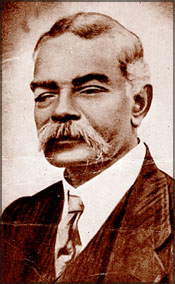|
observer |
|
|
|
|
|
OTHER LINKS |

|

|

|
|
John de Silva: Renowned playwright and play producerYesterday, January 13, was the 150th birth anniversary of John de Silva, playwright and play producer who made theatre-going a popular form of entertainment a 100 years ago, and who gave us that enchanting song 'Danno Budunge', which has become part of our national heritage. The hall built behind the Colombo Art Gallery in 1974 was named John de Silva Hall as a memorial to him. His statue, with a book in his hand, stands in Etul Kotte at which floral tributes were made yesterday. To mark his 150th birth anniversary, his great grandson, Mahinda Makalanda has brought out a book 'Nava Yugayaka Pera Gamankaru' (Trail Blazer of a New Era).
John de Silva was born in Kotte, on January 13, 1857 to Christian parents. His birthplace was Telambugahawatta. The family's ancestral name was Makalandage. He started his education at Christian College Kotte, then a leading English school and the first boarding school in the island. It is now Jayawardanapura Maha Vidyalaya. He next went to the Colombo Academy in Pettah, which later became Royal College. By the age of 20, he was a teacher at St. Joseph's College and later at Wesley College. He associated closely with the Sinhala scholar Pundit Batuwantudawa and so had a good command of the Sinhala language, which was then not taught in schools. He was also familiar with Sanskrit literature. It was at the time young John de Silva was a teacher, that Elphinstone Dramatic Company of Bombay, led by K.M. Baliwalla, a handsome Parsee actor-director, came to Colombo and staged their plays. They were musical dramas with plenty of Hindustani and Gujarati songs. The rich and the not-so-rich came to see these plays, and in the six months that Baliwalla's company staged their plays, a theatre-loving, theatre-going public had grown with each performance. Soon, locals like C. Don Bastian began writing and producing plays on the lines of the Baliwalla plays and these entertained the ever-growing numbers of theatre fans. Living in Kotte, close to Colombo, young John de Silva became a theatre fan and he too tried his hand at writing and producing plays like the plays of the Baliwalla Company. His first play Nataraja was staged in 1886. He was then only 20 years old. This was followed by Dascon, the story of the love affair between the Portuguese General and the Sinhala princess Samudra Devi. His next play was Ramayana the story of Rama and Sita. It was first staged on May 31, 1889. The venue was the Floral Hall in Pettah, where many plays were staged. It was staged again on June 5 at the same venue. That night, the Floral Hall caught fire and the curtains, stage sets, costumes were all destroyed. It was rumoured that someone or some group jealous of John de Silva's success had set fire to the hall. John de Silva was shocked and sad. His grief turned into anger and then disgust. He gave up writing plays and joined the Law College and passed out as a Proctor. Later that year, still angry, he published the play under the title Sita Haranaya (Abduction of Sita) or Ginigath Ramayana (That title Ramayana that caught fire remained while Sita Haranaya was forgotten). His practice as a proctor must have brought John de Silva a good income, but the lure of the theatre was too strong. With the staging of Siri Sangabo in 1930 began his second and best phase as playwright and producer. The song 'Danno Budunge' is still sung and still loved, 103 years after it was first sung on stage by the three princess Sanghatissa, Sangha Bodhi and Gothabhaya as they were approaching Anuradhapura - "Anuradha Nagaraya, dan penay ossay." This lyric and those in John de Silva's other plays were set to music by an Indian musician Wishvanath Lavuji. It is his tunes that made the songs so popular. Other songs still sung and enjoyed by listeners are 'Vessantara raja puta' from the play Vessantara and Amba damba naarang kesel del' sung by Hanuman, the monkey, in Ramayana. The marching song 'Antara Veyitira' in Sri Wickrma was the inspiration for the LSSP's signature song 'Saa dukin pelanavun.' After the success of Siri Sangabo, his group of actors - there were no actresses then - became professionals under the name Arya Subodha Natya Sabha. By then, John de Silva had become a Buddhist and a devotee of the Hindu gods Vishnu and Kataragama. John de Silva wrote plays based on stories in Sanskrit plays, Shakespeare's plays such as Othello and Hamlet and on stories from our own history - Ehelepola and Sri Wickrama. He wrote plays not only to entertain the public. Through his plays, he tried to inspire in the people a sense of pride in our heritage and love for the country. In his own way, he was contributing to the national movement to regain our independence. He was among the Sinhala leaders arrested and jailed after the riots of 1915. The plays John de Silva wrote, and all musical plays of that type are called Nrtti. 'Tower Hall Plays' is another name for those plays because the Tower was the venue for these plays after the hall was opened in December 1911. When we speak of John de Silva and his Nrtti, the Tower Hall immediately comes to mind. But many years passed before John de Silva staged a play there. In the first year, after the opening, only plays by his rival Charles Dias were staged at the Tower Hall, which was built by his father-in-law Don Hendrik Seneviratna. The last play that John de Silva wrote was Nagananda based on a Sanskrit story. That was in 1919. Like his birth, John de Silva's death was also in January. He died, after a brief illness, on January 28, 1922. He was 65 years old then. He had injured his foot while swimming in the sea. Being a diabetic, the wound had proved fatal. |












